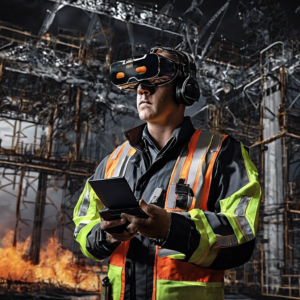The oil and gas industry is increasingly leveraging Augmented Reality (AR) and Virtual Reality (VR) technologies, including immersive technology, to enhance training and ensure safety, particularly through virtual reality training for rig site emergency simulations. This evolution of this approach marks a significant step forward, highlighting the industry’s commitment to minimizing hazards and preparing personnel effectively for potential emergencies through enhanced VR experiences.
These immersive VR training programs offer hands-on experience with hazardous situations, including spills, offshore disaster preparedness, and emergency detection, far beyond traditional training methods. They not only aim to increase safety and confidence in dealing with dangerous incidents but also to modernize emergency preparedness training for the challenging environments of oil and gas operations, emphasizing safety procedures for oil spills and offshore operations.
The Evolution of Emergency Training for Oil Rig Workers
Regulatory Milestones and Changes
- Introduction of the Outer Continental Shelf Lands Act (1953) established to allow the U.S. government to regulate the offshore energy and mineral extraction industry, setting the stage for more structured safety protocols in offshore operations.
- Creation of the Minerals Management Service (1982): This entity was tasked with overseeing and regulating offshore energy, marking a significant step in formalizing safety and operational standards for offshore activities.
- Impact of the Deepwater Horizon Disaster (2010): This event underscored critical weaknesses in oil rig safety culture and emergency response, leading to a major regulatory overhaul for offshore operations.
- Transformation into BOEMRE and Subsequent Split (2010-2011): Initially renamed the Bureau of Ocean Energy Management, Regulation and Enforcement, it was later divided into three bodies in 2011—BSEE, BOEM, and ONRR—to enhance focus on safety and environmental enforcement.
Enhancements in Safety and Preparedness
- BSEE’s Role in Promoting Safety: Established to enforce safety and environmental protection, BSEE implemented reforms such as enhanced well design standards, increased inspection efforts, and promoted a safety culture, including rigorous safety procedures.
- Advancements in Emergency Preparedness: Emphasis on comprehensive preparedness plans, regular drills, and simulations to equip workers to handle high-pressure situations effectively.
- Key Preparedness Components: Focus areas include handling emergency responses, extreme weather conditions, hazardous materials, and medical emergencies effectively.
Integration of VR in Emergency Training
- Effectiveness of VR Training: VR experiences have proven to complement traditional tabletop exercises, offering dynamic, interactive scenarios that enhance the training experience and improve disaster preparedness.
- Practical Implementation: Organizations use VR exercises to test and refine response strategies to major incidents, enhancing the overall effectiveness of emergency training programs.
- Case Study – GTI Energy’s VR Simulation: Developed with OTD funding, this simulation prepares utility natural gas personnel for emergency leak responses, showcasing the practical application of VR in real-world settings, particularly in managing gas leaks.
Key Features of VR Training Simulators for Rig Site Emergencies
Realistic and Interactive Training Scenarios
- Life-Like Experience Creation: VR technology is pivotal in simulating real-life-like environments that provide a safe yet realistic training ground for workers, enhancing their readiness for actual emergencies.
- Equipment and Structure Inspection: Through VR, workers can virtually inspect equipment, pipelines, and offshore structures, allowing for early detection of potential issues that could lead to emergencies, with a focus on offshore safety.
- Maintenance Efficiency: VR simulations not only improve the accuracy of inspections but also streamline maintenance procedures, thus prolonging the lifespan of vital equipment.
Enhanced Safety and Preparedness
- Scenario-Based Training: VR-based training is designed to improve emergency response times and enhance the overall safety of rescue teams by offering scenario-based exercises.
- Multi-User Emergency Response Scenarios: Including features like multi-user functionality and scenario randomization, VR training modules prepare teams for natural gas leak emergencies and other critical incidents, emphasizing readiness for gas leaks.
Cost-Effectiveness and Accessibility
- Reduction in Training Costs: VR training methods are noted for their ability to reduce costs associated with traditional training approaches, including travel costs, making them a more accessible option for many companies.
- Advancements in Technology: Continuous improvements in VR technology, coupled with AI integration, are expected to further decrease costs and enhance the personalization and accessibility of training modules.
AR Application in Maintenance and Emergency Response
- AR in Maintenance: Augmented Reality applications aid in the regular maintenance of crucial rig equipment by enabling predictive maintenance and identifying potential failure points efficiently, with a special focus on offshore equipment.
- Remote Troubleshooting: AR technology also reduces maintenance costs by facilitating remote troubleshooting and expert guidance, which minimizes downtime and transportation expenses.
Specialized Simulators for Comprehensive Training
- TrainBeyond’s Emergency Simulators: TrainBeyond offers specialized VR simulators tailored for training in handling typical well drilling accidents and other emergency scenarios specific to the oil and gas industry, including offshore rig operations, ensure preparedness for real-world challenges.
- Comprehensive Features: These simulators boast features like highly realistic 3D scene displays, customization options, precise mathematical and physical models, and robust after-sale services.
Real-Time Performance Feedback
- Performance Evaluation: VR training simulators provide real-time feedback Feedback on participants’ performance allows for immediate identification of areas needing improvement and helps refine emergency response skills.
Industry-Specific Training Modules
- FPSO Operations: The focus on FPSO operations in VR training highlights the industry-specific nature of these simulators, ensuring that they meet the unique challenges faced in floating production storage and offloading scenarios.
- Compliance and Safety Standards: VR training modules also emphasize the importance of identifying and inspecting personal protective equipment and adhering to safety procedures, which are crucial for maintaining safety standards in hazardous environments.
By incorporating these key features, VR training simulators are significantly enhancing emergency preparedness and response capabilities at offshore rig sites, offering a comprehensive and efficient training solution tailored to the specific needs of the oil and gas industry.


